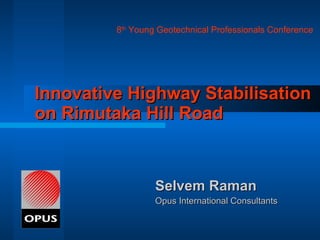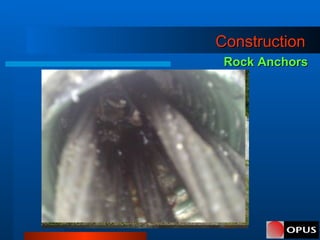Innovative Slope Stabilisation Works
- 1. Innovative Highway Stabilisation on Rimutaka Hill Road Selvem Raman Opus International Consultants 8 th Young Geotechnical Professionals Conference
- 2. Outline Design & Build Concept Background Remedial Design Solution Construction Conclusion Interactive Session (Q & A)
- 3. Background Who's Who ? Principal ŌĆō TRANSIT NZ (now NZTA) PrincipalŌĆÖs Advisor ŌĆō MWH D & B Contractor ŌĆō Fulton Hogan Designer ŌĆō Opus International Consultants
- 6. Background Site Features 1 2 3 4 5
- 7. Background Principal's Requirement Design to TRANSITŌĆÖs Bridge Manual Design Durability life of 50 years Reduced Seismic Design with PGA of 0.2g Other relevant specifications and codes Cost savings shared 50:50 with the Principal This section of the road will be realigned in 20 years Specimen Design : For tenderers information and scheme and statutory applications only!!!!!
- 8. Design & Build Concept Teaming Up ŌĆō Contractor & Consultant Challenge ŌĆō Proactive & Collaborative Approach Innovation ŌĆō Eager to Win Risk Management The Winning Bid ŌĆō Innovative Design Internal & External Design Review Construction Stage - Perception Resolving Problems ŌĆō Collaborative Approach
- 9. Remedial Design Solution Segmentation DEEPER BEDROCK
- 10. Remedial Design Solution Soldier piles with rock anchors Soldier piles with deadman anchors Shallow Bedrock
- 11. Remedial Design Solution Contiguous bored piles with 2 levels of rock anchors Soil nailing of the slope below the road 3 rows of concrete columns along the edge of the road Deep Bedrock
- 12. Remedial Design Solution Final Design
- 13. Remedial Design Solution Unanchored Soldier Pile wall, where depth to bedrock is up to 3 m Anchored Soldier Pile wall, where depth to bedrock is 3 m to 13 m Ground Improvement Piles, where depth to bedrock is greater than 13 m Final Design
- 14. Remedial Design Solution Soldier Pile wall Ground Improvement Piles Rock Anchors Final Design
- 15. Remedial Design Solution Strip Drains Weepholes Trench cut-off drains Kerb drain Sub-horizontal drainage holes New discharge culverts New culvert outlets connected to flexible hose Hydroseeding (stability, drainage & aesthetics) Drainage Measures KEY IMPROVEMENT REQUIRED!!!!!
- 16. Construction Quality Control Issues Site Issues Material Testing ŌĆō Concrete, grout, strand, etc. Pile Testing ŌĆō Down-hole camera, Sonic Logging, TDR Rock Anchor ŌĆō Pull-out testing, down-hole camera, Suitability & Acceptance testing Contractor still expected Consultant to take charge Proceeded smoothly
- 20. Current View
- 21. Conclusion Innovative Design Concept ŌĆō Cost effective and robust solution D & B method - a comparable if not cost effective alternative to conventional procurement method The contractor was delighted ŌĆō all the issues were resolved amicably The principal was satisfied - project proceeded smoothly and value for money PrincipalŌĆÖs Advisor was happy - contract management went smoothly
- 22. Conclusion Innovation essential to win D & B Projects Proactive risk management fundamental when innovating and in D&B environment Issues with Independent Checkers ŌĆō Innovative designs, not traditional! Contractors expect Designers to exercise control even in a D & B environment Approach issues together and solve them! If we can help resolve contractors problems ŌĆō better relationship Any more D & B projects New Zealand????? Lessons Learned
- 23. Acknowledgements Transit New Zealand NZ Geotechnical Society & EQC Fulton Hogan Opus International Consultants
- 24. Q&A ?























